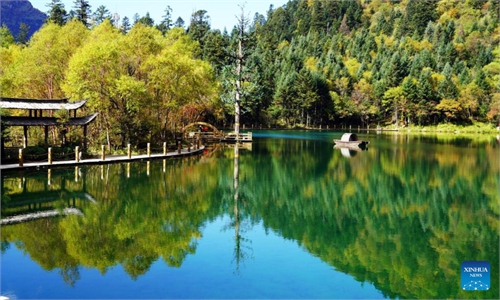China's national park law to be submitted for review by top legislator this year: National Forestry and Grassland Administration

Three-River-Source National Park Photo: VCG
China has included national park law into the legislative work of the State Council this year, and it is expected to be submitted for review by the top legislator within the year, the National Forestry and Grassland Administration (NFGA) revealed on Monday, marking another major milestone in building world's largest national park system.
While the legal process of the national park law remains ongoing, China has rolled out several regulations aimed at protecting national parks during the transition process, according to Tian Yongcheng, an official from the NFGA.
In October 2021, China announced it would formally establish its first group of five national parks, including the Sanjiangyuan (the Three-River-Source) National Park, the Wuyi Mountain National Park, the Giant Panda National Park, the Northeast China Tiger and Leopard National Park and the Hainan Tropical Rainforest National Park.
According to Tian, the first group of national parks has already achieved significant conservation results.
Forest coverage of the Sanjiangyuan National Park already exceeds 74 percent, and the population of Tibetan antelopes in the park has recovered to over 70,000, recovery from less than 20,000 in the 1990s.
The Giant Panda National Park protects more than 70 percent of the wild giant panda population and has established ecological corridors for 13 local populations. Northeast China Tiger and Leopard National Park has seen a continuous increase in unique species, with over 50 wild Siberian tigers and 60 Amur leopards, Tian introduced.
Tian said that the Hainan Tropical Rainforest National Park have strengthened the protection and restoration of rainforest habitats, leading to the recovery of a population of 37 Hainan gibbons in six groups. The Wuyi Mountain National Park has uncovered 17 new species in recent years, including the Rain God Angle Frog and Fujian Gastrodia.
In December 2022, China took another step, setting out a plan that envisages the creation of the world's largest national park system by 2035. The plan includes a total of 49 candidate sites for the establishment of national parks.
The government also issued is the "National Park Spatial Layout Plan". Tian explained that according to the plan, the 49 candidates for national parks will cover a total area of approximately 1.1 million square kilometers, accounting for 10.3 percent of the country's land area, and governing an area of 110,000 square kilometers of sea.
China will have the largest national park system in the world, in terms of protected areas, if all 49 candidate parks are established, according to the plan.
These areas are home to over 5,000 species of terrestrial vertebrates and 29,000 species of higher plants, protecting over 80 percent of the country's key protected wildlife and their habitats.
By establishing national parks, the most important natural ecosystems, unique natural landscapes, essential natural heritages, and rich biodiversity will be protected, leaving valuable natural assets for future generations.
The construction of national parks will benefit more than 400 counties in 28 provinces, forming a grand pattern where 56 ethnic groups share the ecological well-being of national parks.


